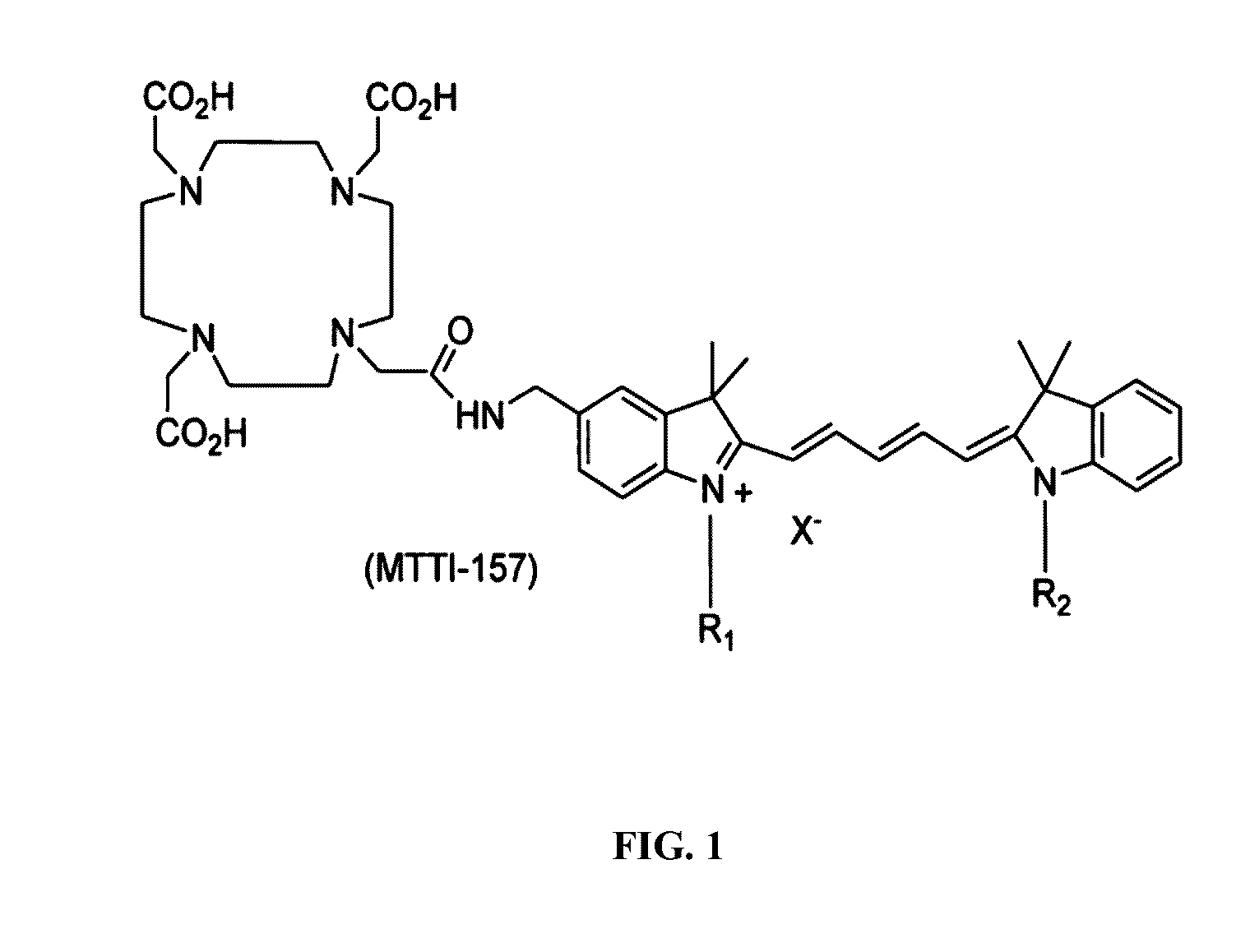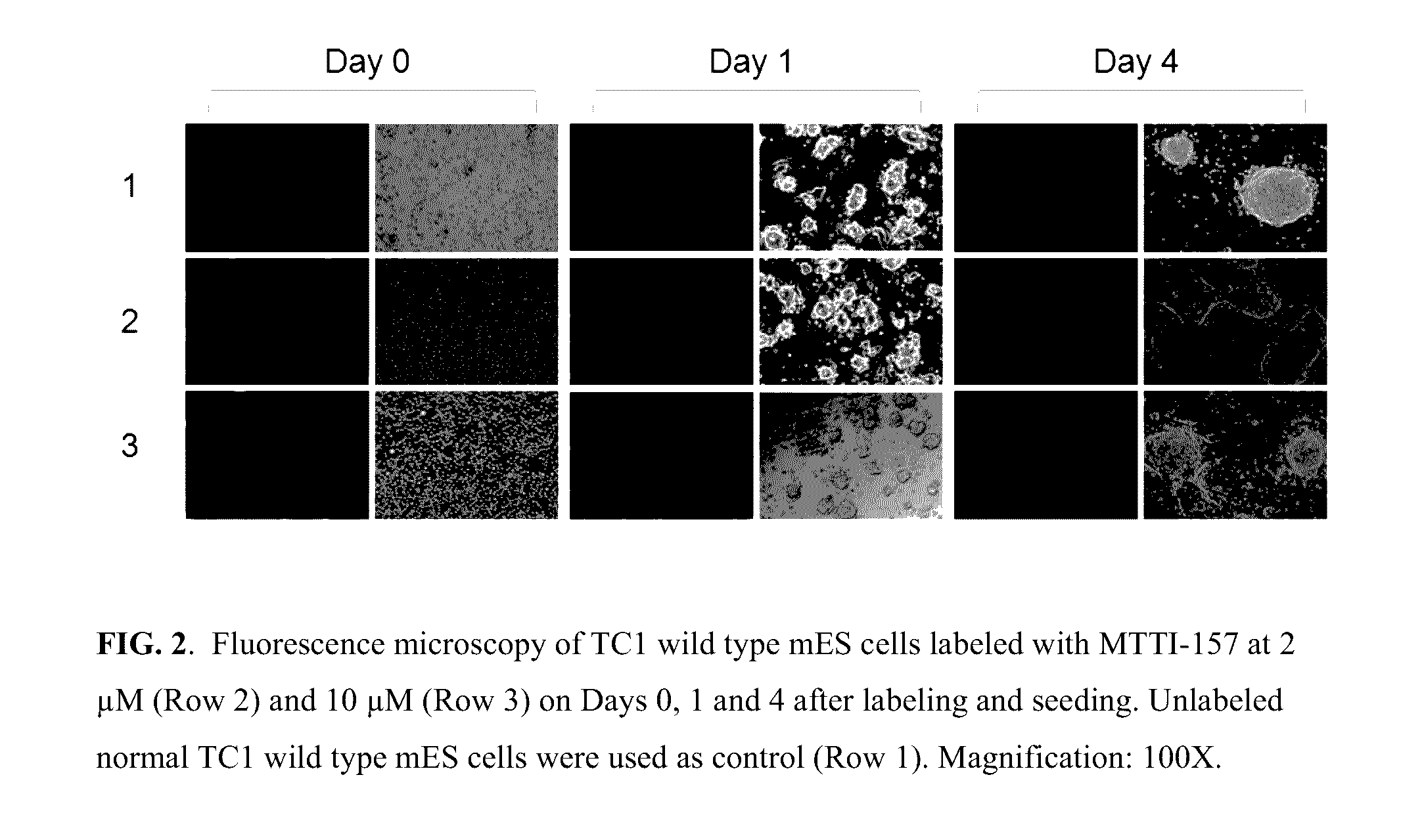Molecular probes for multimodality imaging and tracking of stem cells
a multi-modality, stem cell technology, applied in the field of imaging probes, can solve the problems of label efflux from cells, cell death, cell death, etc., and achieve the effect of accurate determination of stem cell biodistribution
- Summary
- Abstract
- Description
- Claims
- Application Information
AI Technical Summary
Benefits of technology
Problems solved by technology
Method used
Image
Examples
example 1
Preparation of Exemplary Compounds (as Shown in Scheme 1)
[0136]Preparation of Compound (1):
[0137]Compound (1) was prepared according to the procedure of Gale et al. (1977).
[0138]Preparation of Compound (2):
[0139]Compound (1) (20.6 g, 0.065 mol) and n-docosanyl-4-chlorobenzenesulfonate (32.4 g, 0.065 mol) were heated together at 130° C. with stirring for 2 h. The mixture was then cooled to RT and the crude solid recrystallized from ethyl acetate to yield pure (2) (36.4 g, 69%). 1H NMR (CDCl3, 200 MHz): δ7.50-7.90 (m, 8H), 7.20-7.30 (m, 3H), 4.95 (s, 2H), 4.65 (t, 2H), 2.95 (s, 3H), 1.7-1.9 (m), 1.55 (s, 6H), 1.10-1.40 (m), 0.85 (t, 3H).
[0140]Preparation of Compound (3):
[0141]Compound (2) (36 g, 0.044 mol) was dissolved in concentrated hydrochloric acid (660 mL) and the solution slowly heated to 115° C. over 2 h and then refluxed at this temperature for 22 h. The solution was then cooled to RT and placed in and ice bath and then taken to pH=9 with 30% ammonium hydroxide solution. The ...
example 2
Preparation of Example Compounds (as Shown in Scheme 2)
[0160]The amine functionalized dye (8) was reacted with glutaric anhydride to provide (12). Standard coupling of (12) with 2-(4-aminobenzyl) diethylenetriamine penta-t-butyl acetate (www.macrocyclics.com) using HATU provided (13) which was purified via column chromatography and isolated in high yield. Removal of the t-butyl esters from (13) was accomplished by treating with TFA in dichloromethane to furnish the free acid (14). (14) was used to prepare both natural and indium-111 labeled (15) using methods similar to those described above for labeling (10).
[0161]
[0162]Scheme 2 shows synthetic scheme for preparing non-radioactive and radioactive indium labeled compounds of the invention with a DTPA chelator. Reagents: (i) glutaric anhydride (ii) 2-(4-aminobenzyl) diethylenetriamine penta-t-butyl acetate, HATU (iii) TFA / CH2Cl2 (60:40) (iv) EtOH, natInCl3, 0.25M NaOAc or EtOH, 111InCl3, 0.25M NaOAc.
example 3
Stem Cells Labeling with MTTI-157 (No 111In)
[0163]TC1 wild type mouse embryonic stem (mES) cells were cultured in M15 medium (high glucose DMEM with 2 mM glutamine, 100 U / ml Pen / Strep, 0.1 mM beta mercaptoethanol, 15% FBS and 1000 U / ml murine leukemia inhibitory factor) on a freshly prepared gelatinized 100-mm tissue culture dish at 37° C. in a humidified atmosphere with 5% CO2. Medium was changed every day and cells passed every other day. For labeling with MTTI-157, the TC1 wild type mES cells were trypsinized, collected from the dishes, and washed twice with high glucose DMEM without serum. The washed cells were resuspended in Diluent C at the concentration of 2×107 cells / ml. Immediately, prior to staining, a 2× working stock solution of MTTI-157 (4 μM, and 20 μM) was prepared in Diluent C. Then 1 ml of the cell suspension was added rapidly into 1 ml of the 2× working dye solution and immediately mixed by pipetting. The final staining solutions were 2 μM and 10 μM. After incubati...
PUM
| Property | Measurement | Unit |
|---|---|---|
| wavelengths | aaaaa | aaaaa |
| temperature | aaaaa | aaaaa |
| volume | aaaaa | aaaaa |
Abstract
Description
Claims
Application Information
 Login to View More
Login to View More - R&D
- Intellectual Property
- Life Sciences
- Materials
- Tech Scout
- Unparalleled Data Quality
- Higher Quality Content
- 60% Fewer Hallucinations
Browse by: Latest US Patents, China's latest patents, Technical Efficacy Thesaurus, Application Domain, Technology Topic, Popular Technical Reports.
© 2025 PatSnap. All rights reserved.Legal|Privacy policy|Modern Slavery Act Transparency Statement|Sitemap|About US| Contact US: help@patsnap.com



